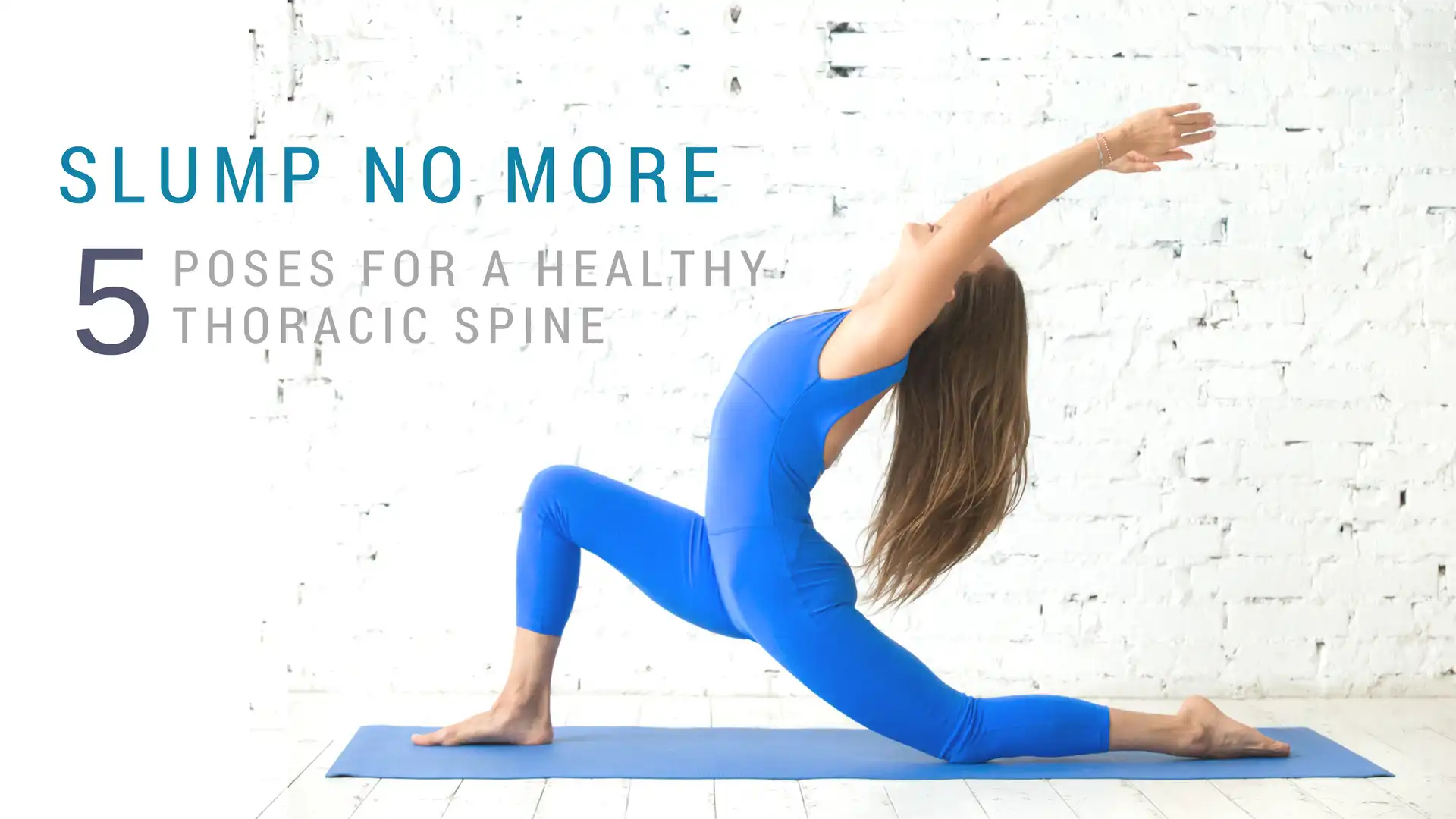Slump No More: 5 Poses for a Healthy Thoracic Spine

The thoracic spine lies between the bones of the lower back and the neck bones. It is a unique area of the spine. All your ribs attach to the transverse processes of the vertebrae in the thoracic spine and wrap around to plug in directly or indirectly to the breastbone in front of your chest. Your rib cage does an excellent job of protecting your heart and lungs, but it limits movement of this section of the spine to some degree.
As we age, most people tend to round forward in this area, and if unchecked, this can lead to the appearance of a hump in the upper back, called kyphosis. Add to the stiffness and wear and tear on the spinal joints caused by the normal aging process, and you could end up with limited mobility and an achy back.
I occasionally experience pain in this area (upper back), just off to the right side of my thoracic spine, usually while doing a longer sitting meditation. I have attributed this dull, aching pain to a little functional scoliosis, which I suspect I have—a function of playing the violin since age 5. The good news is that once my sit is over and I do a little movement, the area quiets down nicely and does not bother me until the next longer sit. A practice such as the one that follows will help keep the area more mobile over time.
Caution: If you have trouble with balance, practice Arms Overhead Pose (Urdva Hastasana) and Crescent Moon Pose, a.k.a. Palm Tree Pose (Talasana), with your back near a wall.
1. Arms Overhead Pose for a Healthy Thoracic Spine
I love this pose because you get a two-for-one. You start in Mountain Pose (Tadasana), bringing attention to your general posture, which I feel is essential to maintaining the health of the thoracic spine. Then, you extend your arms overhead, which moves your thoracic spine into a slight backbend. I usually do a dynamic version of this pose for six breaths as a warm-up and then try to hold the pose for 6-12 breaths.
 Stand in Mountain Pose with strong legs and a long spine for about 6 to 12 breaths.
Stand in Mountain Pose with strong legs and a long spine for about 6 to 12 breaths.- On your inhalation, raise your arms up alongside your ears, and on your exhalation, release them back to your sides. Practice this dynamic sequence for six rounds of breath.
- After round 6, inhale and extend your arms up alongside your ears, lifting from your hips to your hands as you keep your legs strong and steady. Stay in the pose for 6 to 12 breaths. (Those with untreated high blood pressure should stay for only four breaths).
- To come out of the pose, exhale and release your arms to your sides. Stand in Mountain Pose for a few breaths.
2. Crescent Moon Pose
This variation of Arms Overhead Pose is a great way to develop more side-bending ability in your thoracic spine. I practice this pose dynamically from side to side and then hold it on each side for 3 to 6 breaths.
 Standing in Mountain Pose, inhale and raise your arms alongside your ears.
Standing in Mountain Pose, inhale and raise your arms alongside your ears.- As you exhale, bend your upper body and arms to the right about 6 to 12 inches while keeping your legs strong. Then, inhale back to vertical. Exhale to the left and inhale back to center. Repeat two more times side-to-side.
- Release your arms to your sides for a few breaths in Mountain Pose.
- Return to Arms Overhead Pose, and then move into Crescent Moon Pose to the right and stay for 3 to 6 breaths.
- Return to vertical and repeat on the left for 3 to 6 breaths.
- To come out of the pose, return to vertical and release your arms to your sides.
- Stand in Mountain Pose for a few breaths
3. Easy Sitting Twist
This pose is an excellent way to strengthen and stretch the muscles that twist your thoracic spine to the right and left. I usually start with a dynamic version of the pose and then finish by holding the twist on each side.
 Sit on the floor in an Easy Sitting Pose (Sukhasana). Sit a bit higher on a folded blanket if your lower back is rounding back.
Sit on the floor in an Easy Sitting Pose (Sukhasana). Sit a bit higher on a folded blanket if your lower back is rounding back.- Inhale and raise your arms out to your sides, even with your shoulders. Then exhale and twist to the right, bringing your left hand to your right knee and your right hand to the floor behind you.
- Inhale and come back to center, with arms out to sides. Exhale and twist to your left, bringing your right hand to your left knee and your left hand to the floor behind you. Inhale and come back to the center with arms out to the sides.
- Exhale and release your arms down alongside your body. Then, repeat the entire sequence two more times.
- After practicing the dynamic twist, come back into the twist on your right side, and maintaining a long, lifted spine, stay for 6 to 12 breaths. Then release back to center and repeat the twist on your left.
- Sit in an Easy Sitting Pose for a few breaths.
4. Restorative Child’s Pose and Your Thoracic Spine
This pose is a great way to release tightness in the upper back area. Many of us hold tightness along the sides of the thoracic spine and between the shoulder blades, and this version of Child’s Pose (Balasana) with a bolster is a gentle way to release these tight areas.
 Place a rectangular folded blanket across the center of your mat.
Place a rectangular folded blanket across the center of your mat.- Have a round bolster handy, off to one side.
- Kneel near the front edge of the blanket with your shins on it, your toes pointing back, and your big toes touching.
- Sit back on your heels and separate your knees about a foot apart.
- Slide the bolster right up against your pubic bone and lower belly. (If the bolster has become flattened with use, turn it on the higher side.)
- Lower your belly, chest, and head onto the bolster, and turn your head to one side.
- Take your arms out to your sides to widen your upper back.
- Set a timer for two minutes and rest in the pose. When the timer goes off, turn your head to the other side, reset the timer, and rest for two more minutes.
- Use your hands to push against the floor, roll up, and come to a comfortable sitting position for a few breaths.
5. Supported Reclined Bound Angle Pose (With Bolster)
This pose is a great way to end a short practice for the thoracic spine, as it is both a relaxing ending pose and a gently supported backbend for the thoracic spinal area. Be sure to prop your legs so you don’t feel any stretching sensations. Before entering the pose, you might want to set a timer for 5 to 10 minutes so you can completely relax.
 Place a bolster lengthwise along the long axis of your mat, and place one or two blocks underneath the bolster to create a sloping angle toward the front of the mat.
Place a bolster lengthwise along the long axis of your mat, and place one or two blocks underneath the bolster to create a sloping angle toward the front of the mat.- Add a folded blanket or towel at the far end to support your head and neck.
- Sit in front of the bolster (not on it), and come into Bound Angle Pose (Baddha Konasana). Support your hips and knees with blocks or rolled blankets.
- Use your hands to lower yourself onto the bolster.
- Position your arms out to your sides with the backs of your hands on the floor.
- Close your eyes and focus on releasing tension in your chest, shoulders, spine, and hips.
- Bring your knees together and roll to one side, coming off your props, to come out of the pose.
- Take a few moments in a sitting position to check in with your thoracic spine and the rest of your body. Notice if the sequence created any new sense of openness, freedom, or aliveness in your upper back and body.
Photos courtesy of Melina Meza
Also, read...
4 Easy Ways to Use a Sandbag in Yoga Practice
Exercise and Longevity: Diversify Your Yoga Practice for Maximum Benefits
Glute Amnesia: Yoga for Your Forgotten Rear
Related courses
Breath as Medicine: Yogic Breathing for Vital Aging
Yoga and Myofascial Release: Releasing Chronic Tension with the Bodymind Ballwork Method

Baxter Bell, MD, C-IAYT, YACEP, fell in love with yoga in 1993 while he was working full-time as a family physician. His appreciation for the potential of yoga to foster health, healing, and equanimity was so great that he soon stepped down from his medical practice and trained to become a yoga teacher. Now, he focuses on teaching yoga full time, both to ordinary students of all ages and physical conditions and to the next generation of yoga teachers and yoga therapists, to whom he teaches anatomy and yoga therapy along with his accessible, skillful style of yoga. He also sees students privately, helping them use yoga to help heal from and/or cope with a wide range of medical conditions. At this point, with 23+ years of teaching experience under his belt, Baxter brings a unique perspective to his teaching, combining his understanding of anatomy and medicine with his skill at instructing people from all walks of life and all levels of ability.
In addition to teaching classes, workshops, and retreats internationally, Baxter is a past presenter at Yoga Journal Conferences and the International Association of Yoga Therapy’s Sytar Conference and teaches online courses and classes at Yoga U Online. Baxter is also the co-author of the popular and ground-breaking book Yoga for Healthy Aging and his blog, “What’s On Your (Yoga) Mind,” where he shares his knowledge of medical conditions, anatomy, yoga, and more with practitioners and teachers across the world. He has written articles for the Yoga Journal and the Journal of the International Association of Yoga Therapy. He is often quoted as an expert on yoga and health by major national news outlets such as the Washington Post and the Wall Street Journal. To learn more, visit www.baxterbell.com, and his YouTube channel and Instagram page at Baxter Bell Yoga.



